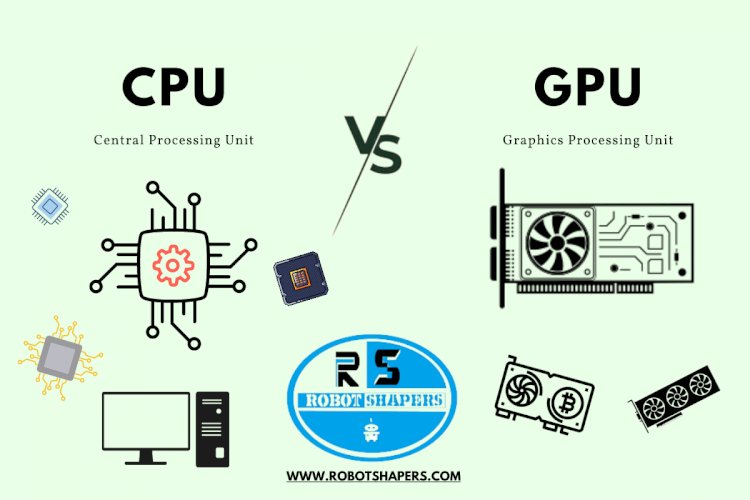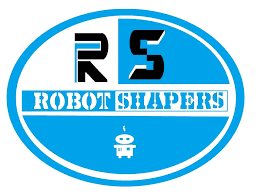Difference Between CPU and GPU
Differences between CPU and GPU - CPU stands for Central Processing Unit. GPU stands for Graphics Processing Unit. The main difference between a CPU and a GPU is how they process the instructions given to them.

What is CPU?
CPU (Central Processing Unit) is a device primarily acts as the brain for every embedded system or for your computer. The main job of the CPU is to carry out a diverse set of instructions through the fetch-decode-execute cycle to manage all parts of your computer and run all kinds of computer programs i.e. it consists of an ALU (Arithmetic Logic Unit) used to temporarily store the data and perform calculations and a Control Unit which performs instruction sequencing and branching. It also interacts to the other units of the computer such as memory, input and output, for executing the instruction from the memory this is the reason an interface is also a crucial part of the CPU. The I/O interface is sometimes included in the control unit.
It provides address, data and control signal while receives instructions, data, status signal and interrupt which is processed with the help of the system bus. A system bus is a group of various buses such as address, control and data bus. The CPU assigns more hardware unit to fast cache while low to computation, unlike GPU.
CPU Architecture
A CPU is very fast at processing your data in sequence, as it has few heavyweight cores with high clock speed. It’s like a Swiss army knife that can handle diverse tasks pretty well. The CPU is latency-optimized and can switch between a number of tasks real quick, which may create an impression of parallelism. Nevertheless, fundamentally it is designed to run one task at a time.
CPU Limitations
Heavyweight Instruction Sets
A tendency to embed increasingly complex instructions into CPU hardware directly is a modern trend that has its downside. In order to execute some of the more difficult instructions, a CPU will sometimes need to spin through hundreds of clock cycles. Although Intel uses instruction pipelines with instruction-level parallelism to mitigate this limitation, it is becoming an overhead to overall CPU performance.
Context Switch Latency
Context switch latency is time needed for a CPU core to switch between threads. Switching between tasks is quite slow, because your CPU has to store registers and state variables, flush cache memory and do other types of clean up activities.
Though modern CPU processors try to facilitate this issue with task state segments which lower multi-task latency, context switching is still an expensive procedure.
Moore's Law
The notion that the number of transistors per square inch on an integrated circuit doubles every two years may be coming to an end. There is a limit to how many transistors you can fit on a piece of silicon, and you just cannot outsmart Physics.
Rather, engineers have been trying to increase computing efficiency with the help of distributed computing, as well experimenting with quantum computers and even trying to find a silicon replacement for CPU manufacturing
What is GPU?
The GPU (Graphics Processing Unit) is a specialized processor whose job is to rapidly manipulate memory and accelerate the computer for a number of specific tasks that require a high degree of parallelism. It is typically incorporated with CPU for sharing RAM which is good for the most computing task. It is needed for the high-end graphics intensive processing. The discrete GPU unit contains its own RAM known as VRAM for video RAM. The advanced GPU system cooperatively works with the multi-core CPUs. At first, the graphics unit was introduced by the Intel and IBM in the 1980s. These cards were enabled with simple functionalities such as area filling, alteration of simple images, shape drawing and so on.
The modern graphics are capable of performing the research and analysis task, often surpassing CPUs because of its extreme parallel processing. In the GPU the several processing units are stripped together where no cache coherency exist.
GPU Architecture
As the GPU uses thousands of lightweight cores whose instruction sets are optimized for dimensional matrix arithmetic and floating point calculations, it is extremely fast with linear algebra and similar tasks that require a high degree of parallelism.
As a rule of thumb, if your algorithm accepts vectorized data, the job is probably well-suited for GPU computing.
Architecturally, GPU’s internal memory has a wide interface with a point-to-point connection which accelerates memory throughput and increases the amount of data the GPU can work with in a given moment. It is designed to rapidly manipulate huge chunks of data all at once.
GPU Limitations
Less Powerful Cores
Although GPUs have many more cores, they are less powerful than their CPU counterparts in terms of clock speed. GPU cores also have less diverse, but more specialized instruction sets. This is not necessarily a bad thing, since GPUs are very efficient for a small set of specific tasks.
Less Memory
GPUs are also limited by the maximum amount of memory they can have. Although GPU processors can move a greater amount of information in a given moment than CPUs, GPU memory access has much higher latency.
Limited APIs
The most popular GPU APIs are OpenCL and CUDA. Unfortunately, they are both renowned for being hard to debug.
Although OpenCL is open source, it is quite slow on Nvidia hardware. CUDA, on the other hand, is a proprietary Nvidia API and is optimized for Nvidia GPUs, but it also automatically locks you in their hardware ecosystem.
Here’s the basic Difference Between CPU and GPU :-
|
Basis of Distinction |
CPU |
GPU |
|
Full Form |
Central Processing Unit |
Graphics processing Unit |
|
Type of Instruction processing |
Serial |
Parallel |
|
Memory Consumption |
High |
Low |
|
Processing Speed |
High |
Comparatively High |
|
Focuses On |
Low-Latency |
High throughput |
|
Feature |
Control logic for out-of-order and speculative executions. |
Architecture is tolerant of memory latency. |
|
Cores |
Several Cores |
Many Cores |
|
Operations |
Can do a handful of operations at once |
Can do thousands of operations at once. |
|
Instruction |
Many diverse instruction sets. |
A few highly optimized instruction set |
|
Threads |
Explicit thread management |
Threads are managed by hardware. |
CPUs and the End of Moore’s Law
With Moore’s law winding down, GPUs, invented by NVIDIA in 1999, came just in time.
Moore’s law posits that the number of transistors that can be crammed into an integrated circuit will double about every two years. For decades, that’s driven a rapid increase of computing power. That law, however, has run up against hard physical limits.
GPUs offers a way to continue accelerating applications — such as graphics, supercomputing and AI — by dividing tasks among many processors. Such accelerators are critical to the future of semiconductors, according to John Hennessey and David Patterson.
GPUs: Key to AI, Computer Vision, Supercomputing and More
Over the past decade that’s proven key to a growing range of applications.
GPUs perform much more work for every unit of energy than CPUs. That makes them key to supercomputers that would otherwise push past the limits of today’s electrical grids.
In AI, GPUs have become key to a technology called “deep learning.” Deep learning pours vast quantities of data through neural networks, training them to perform tasks too complicated for any human coder to describe.
AI and Gaming: GPU-Powered Deep Learning Comes Full Circle
That deep learning capability is accelerated thanks to the inclusion of dedicated Tensor Cores in NVIDIA GPUs. Tensor Cores accelerate large matrix operations, at the heart of AI, and perform mixed-precision matrix multiply-and-accumulate calculations in a single operation. That not only speeds traditional AI tasks of all kinds, it’s now being tapped to accelerate gaming.
In the automotive industry, GPUs offer many benefits. They provide unmatched image recognition capabilities, as you would expect. But they’re also key to creating self-driving vehicles able to learn from — and adapt to — a vast number of different real-world scenarios.
In robotics, GPUs are key to enabling machines to perceive their environment, as you would expect. Their AI capabilities, however, have become key to machines that can learn complex tasks, such as navigating autonomously.
In healthcare and life sciences, GPUs offer many benefits. They’re ideal for imaging tasks, of course. But GPU-based deep learning speeds the analysis of those images. They can crunch medical data and help turn that data, through deep learning, into new capabilities.
In short, GPUs have become essential. They began by accelerating gaming and graphics. Now they’re accelerating more and more areas where computing horsepower will make a difference.

 Arindam Deshmukh
Arindam Deshmukh 



















